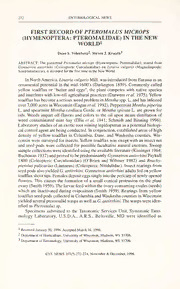
First Record Of Pteromalus Microps (Hymenoptera: Pteromalidae) In The New World PDF
Preview First Record Of Pteromalus Microps (Hymenoptera: Pteromalidae) In The New World
272 ENTOMOLOGICALNEWS FIRST RECORD OF PTEROMALUS MICROPS (HYMENOPTERA: PTEROMALIDAE) IN THE NEW WORLD 1 DeanS.Volenberg^,StevenJ. Krauth^ ABSTRACT: The parasitoid Pteromalus microps (Hymenoptera: Pteromalidae), reared from Gymnetron antirrhini (Coleoptera: Curculionidae) on Linaria vulgaris (Magnoliopsida: Scrophulariaceae),isrecordedforthefirsttimeintheNewWorld. InNorthAmerica,LinariavulgarisMill, wasintroducedfromEurasiaasan ornamental perennial in the mid-1600's (Darlington 1859). Commonly called yellow toadflax or "butter and eggs", the plant competes with native species and interferes with low-till agricultural practices (Darwentetal. 1975).Yellow toadflaxhasbecomeaseriousweedprobleminMenthaspp.L. andhasinfested over7,000acresinWisconsin (Eaganetal. 1992). PeppermintMenthapiperita L. and spearmintMentha cardiaca Gerde. orMenthaspicata L. are grown for oils. Weeds impart off-flavors and colors to the oil upon steam distillation of weed contaminated mint hay (Ellis et al. 1941; Schmidt and Binning 1996). Laboratory studiesofan exoticrootmininglepidopteran asapotential biologi- calcontrolagentarebeingconducted. Inconjunction,establishedareasofhigh density of yellow toadflax in Columbia, Dane, and Waukesha counties, Wis- consin were surveyed forinsects.Yellow toadflax was swept with an insectnet and seed pods were collected for possible facultative natural enemies. Sweep samplecollectionswereidentifiedusingtheavailableliterature(Kissinger 1964; Buchanan 1937)andprovedtobepredominantly GymnetronantirrhiniPaykull 1800 (Coleoptera: Curculionidae) (O'Brien and Wibmer 1982) and Brachy- pteroluspulicarius (Linnaeus) (Coleoptera: Nitidulidae). Insect rearings from seedpodsalsoyieldedG. antirrhini. Gymnetronantirrhiniadultsfedonyellow toadflaxshoottips.Femalesdepositeggssinglyintothepericarpofnewlyopened flowers. This causes the formation of a small conical protrusion on the plant ovary (Smith 1959).Thelarvaefeedwithintheovaryconsumingovules(seeds) which are inactivated during oviposition (Smith 1959). Rearings from yellow toadflaxseedpodscollectedinColumbiaandWaukeshacounties inWisconsin yieldedseveralpteromalidwaspsaswellasG. antirrhini.Thewaspswereiden- tified as Pteromalus sp. Specimens submitted to the Taxonomic Services Unit, Systematic Ento- MD mology Laboratory, U.S.D.A., A.R.S., Beltsville, were identified as 1 ReceivedJanuary30, 1996.AcceptedMarch 16, 1996. 2 DepartmentofHorticulture,UniversityofWisconsin, Madison,WI. 53706. 3DepartmentofEntomology, UniversityofWisconsin,Madison,WI.53706. ENT.NEWS 107(5)272-274,November&December, 1996 Vol. 107,No. 5,November&December, 1996 273 Pteromalusmicrops(Graham).This is thefirstNewWorldrecord forthis Pale- arcticspecies.Pteromalusmicropswasdescribedin 1969fromspecimenstaken in Ireland and Britain (unlocalized) from the same curculionid host. It would appear that it was accidentally introduced along with the weevil which was releasedforpurposesofbiologicalcontrolofLinaria(E.E.Grissell,pers.comm.). Species of P. microps are metallic-green with or without reflections of blue. The coxae and femora, except their tips, are concolorous with the thorax; tro- chanters partly dark; rest oflegs testaceous with tips oftarsi fuscous: the fore tarsimainlybrownish.Wingshyaline; venationyellowishortestaceous. Length 2.6 to 3mm. Males are easily recognized by the characters of the oral fossa, mandibles, ocelli, antennae and propodeum (Graham 1969). Members of the genusattackthe egg, larval and pupal stagesofhosts in the ordersLepidoptera, Coleoptera and Diptera. One member of the genus is a hyperparasite of Bruchophagus (Hymenoptera: Eurytomidae). Voucher specimens from these collections are deposited in the Insect Research Collection ofthe Department ofEntomology, University ofWiscon- sin-Madison.Morerecently,P. micropshasbeenrearedfromMecinusjanthinus (Coleoptera: Curculionidae: Gymnetrinae) in Alberta (Alec McClay, pers. comm.). MATERIAL EXAMINED: WI: Columbia Co., University ofWisconsin Madison, Arlington Experimental Farms, Coll:4-VIII-1995,emerged frompodsofLinaria vulgarix. Coll: D.Volen- berg,sixfemales.WaukeshaCo.,KettleMoraineStateForest,Coll:25-VIII-1994,Emerged:26-IX- 1994, fromseed podsofLinaria vulgarix. Coll: D.Volenberg, twomales, onefemale. Waukesha Co.,KettleMoraineStateForest,Coll:26-IX-1994,sweepsamples.Coll:D.Volenberg,threemales, twofemales. ACKNOWLEDGMENTS Weacknowledgewiththanksthe species level identification ofP. microsbyEricGrissell of theSystematicEntomologyLaboratory,USDA,ARS,Beltsville,MD.Allotheridentificationswere performed by thejuniorauthor. Funding forthis study was provided by Hatch Funds#142D672 directed by H. J. Hopen, Department ofHorticulture, College ofAgricultural and Life Sciences, UniversityofWisconsin-Madison.WethankH.J.HopenandD.L.Mahr,DepartmentofEntomol- ogy,Wisconsinforreviewingthemanuscript. LITERATURECITED Buchanan,L.L 1937. NotesonCurculionidae.J.Wash.Acad.Sci.27:312-316. Darlington,W. 1859.Americanweedsandusefulplants.OrangeJudd&Co., NewYork. Darwent,A.L.,W.Lobay,W.Vanish,andP.Harris 1975.Distributionandimportanceinnorth- westAlbertaoftoadflax(Linnariavulgaris)anditsinsectenemies(Brachypteroluspulicarius, Gymnaetwnantirrhini).Can.J. PlantSci. 55:157-162. Eagen, K.A., T.R. Connell, B.A. Michaelis, R.L. Hughes, HJ. Hopen, and L.K. Binning. 1992.LinariavulgarisseverityandcontrolinWisconsinmint.Report.MintIndustryResearch Council. 274 ENTOMOLOGICALNEWS Ellis, N.K., K.I. Fawcett, F.C. Gaylord, and L.H. Baldinger. 1941 A study ofsome factors affectingtheyieldandmarketvalueofpeppermintoil. PurdueUniv. Bull. No.461.27pp. Graham, M.W.R. de V. 1969. The Pteromalidae of northwestern Europe (Hymenoptera: Chalcidoidea). Bull. BritishMus.(Nat. Hist.)Entomol.Suppl 16: 1-908. Kissinger,D. 1964.CurculionidaeofAmericaNorthofMexico:Akeytogenera.TaxonomicPub. So.Lancaster,Mass. O'Brien, C. andG.J.Wibmer. 1982. Annotated checklist ofthe weevils (Curculionidaesensu lato) ofNorthAmerica, Central America and the West Indies (Coleoptera: Curculionoidea). Mem.Amer.Entomol. Inst. 34:1-382. Schmidt,W.G.andL.K.Binning. 1996. Impactofredrootpigweed(AmaranthuxretroflexusI ), common lambsquarters (Chenopodium album L.) and bamyardgrass (Echinichloa crus-galli L.) on peppermint oil yield and quality. Abstract Proc. ann. meet. Weed Science Soc. Amer. 36:54. Smith, J.M. 1959. Notes on insects, especially Gymnaetwn spp. (Coleoptera: Curculionidae), associated with toadflax, Linaria vulgaris Mill. (Scrophulariaceae) Can. Entomol. 91: 116-121. BOOK REVIEW INSECTS OFTHE GREAT LAKES REGION. Gary A. Dunn. 1996. Univer- sity ofMichigan Press. 324 pp. $42.50Cloth, $17.50ppbk. Inthisbook,theauthorhasdoneanexcellentjobofpresentinganoverviewoftheinsectsof the Great Lakes Region. Although intended for localized, Great Lakes Region readership in its introductorybackgroundinformationandinspeciesselectionthroughout,muchofthesubjectmatter isreadilyapplicabletoanywhereinnortheasternandnorthmiddleAmericaandsouthcentralCanada. IntroductorymaterialincludesachapteronthegeologicalandbiologicalhistoryoftheGreat Lakes Region coveringsubjectssuchas formationoftheGreatLakes,landformsandsoilsofthe region,climaticfactors,pre-andpost-glacialplantandinsectbiologyanddispersal,andthecurrent environmentoftheregion.Anotherchaptercoverstheentomologicalhistoryoftheregion,includ- ingintroducedandendangeredinsectswhileathirdintroductorychapterpresentsacomprehensive reviewofdistributional patternsofinsectsintheGreatLakesRegion. Following introductory information on insect classification and akey to the orders ofadult insects in the region, the main text consists ofdescriptive writing, with marginal illustrations,of eachofthemajorordersandfamiliesofcommoninsectstobefoundintheregion.Foreachorder, the text presents a short introduction followed by sections on over-all descriptions, life cycles, habits and habitats, ecological and economic status, and distribution. For each family, selected specificinsectsareidentifiedbybothcommonandscientificnamesfollowedbyabrief,identifying description.Formostfamiliesthereisafinalparagraphcitingsourcesforadditionalinformationon identificationsandlifehistoriesthatareincludedinthebibliography. Auniquefeatureofthisbookisanumber(9)of"QuickGuidestoIdentification"intheform oftablesorganizedbydiagnosticcharacteristicsthatprovidereadyassistancetomoreeasilysepa- ratetheorders,andthefamiliesinthemajororders.Completingthebookisaglossary,anextensive bibliography, an index, and several appendixes listing entomological organizations, periodicals, institutionalcollections,zoosandbutterflyhouses,andcollectingregulations,alldealingwithin- sectsoftheGreatLakes Region. Overall, this bookwould seemtobean introductory MUSTfor amateurentomologists and insectenthusiasts as well as the general public throughout theGreat LakesRegion. H.P.B.
